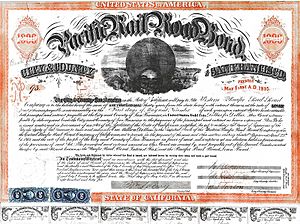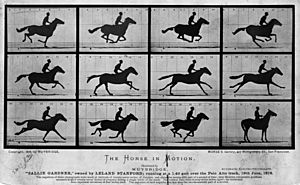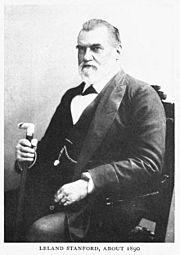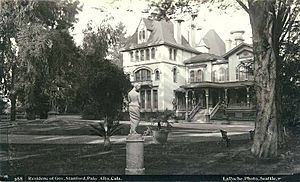Leland Stanford facts for kids
Quick facts for kids
Leland Stanford
|
|
|---|---|
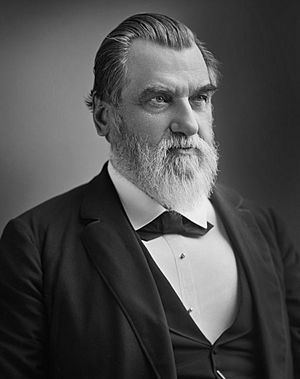
Stanford in 1890.
|
|
| United States Senator from California |
|
| In office March 4, 1885 – June 21, 1893 |
|
| Preceded by | James T. Farley |
| Succeeded by | George Clement Perkins |
| 8th Governor of California | |
| In office January 10, 1862 – December 10, 1863 |
|
| Lieutenant | John F. Chellis |
| Preceded by | John Gately Downey |
| Succeeded by | Frederick Ferdinand Low |
| Personal details | |
| Born |
Amasa Leland Stanford
March 9, 1824 Watervliet, New York, U.S. |
| Died | June 21, 1893 (aged 69) Palo Alto, California, U.S. |
| Political party | Republican (from 1856) |
| Other political affiliations |
Whig (until 1856) |
| Spouse |
Jane Elizabeth Lathrop
(m. 1850) |
| Children | Leland Jr. |
| Alma mater | Cazenovia Seminary |
| Occupation |
|
| Signature | |
Leland Stanford (born March 9, 1824 – died June 21, 1893) was an important American businessman, politician, and generous giver. He was a member of the Republican Party from California.
He served as the 8th Governor of California from 1862 to 1863. Later, he represented California in the United States Senate from 1885 until he passed away in 1893. With his wife, Jane, he founded Stanford University. They named the university after their son, Leland Stanford Jr., who died young.
Stanford was a very successful merchant and businessman. He moved to California during the California Gold Rush and built a large business. He was a powerful leader of the Central Pacific Railroad and later the Southern Pacific Railroad. These roles gave him great influence in the American West. He also played a big part in companies like Pacific Life and Wells Fargo. He is remembered for his lasting impact on California.
Contents
Early Life and Start of His Career
Leland Stanford was born in 1824 in Watervliet, New York. He was one of eight children. His family lived on farms in New York.
He went to school until 1836 and then studied at home. He later studied law at Cazenovia Seminary from 1841 to 1845. In 1845, he began working at a law office in Albany, New York.
After becoming a lawyer in 1848, Stanford moved to Port Washington, Wisconsin. There, he started his own law practice. In 1850, he was nominated to be the district attorney for Washington County, Wisconsin.
Building Businesses
In 1852, Stanford lost his law office and other belongings in a fire. He then moved to California, following his five brothers. This was during the exciting time of the California Gold Rush. His wife, Jane, went back to her family in New York for a while.
Stanford started a business with his brothers. He ran a general store for miners in Michigan City, California. Later, he opened a wholesale business. He also worked as a justice of the peace and helped start the Sacramento Library Association. In 1855, he visited his wife in New York, but he found life there too slow after the fast pace of California.
Central Pacific and Southern Pacific Railroads
In 1856, Leland and Jane Stanford moved to Sacramento, California. There, he became involved in large-scale trading. He was one of four businessmen known as "The Big Four." These four were the main investors in building the Central Pacific Railroad. They officially started the company on June 28, 1861, and Stanford was chosen as its president. The other three partners were Charles Crocker, Mark Hopkins, and Collis P. Huntington.
The Central Pacific's first train engine was named Gov. Stanford in his honor. You can still see this engine today at the California State Railroad Museum in Sacramento.
Stanford tried to become governor of California in 1859 but did not win. He ran again in 1861 and won the election. Because of a huge flood in 1862, he reportedly had to use a rowboat to get to his inauguration ceremony. He served one term as governor, which was two years long at that time.
While the Central Pacific Railroad was being built, Stanford and his partners also gained control of the Southern Pacific Railroad in 1868. Stanford became president of the Southern Pacific. He held this position until 1890, when he was replaced by Collis Huntington.
As the head of the railroad company that built the western part of the "First Transcontinental Railroad", Stanford led a special ceremony. On May 10, 1869, he drove the ceremonial "Last Spike" in Promontory, Utah. This spike connected the Central Pacific Railroad with the Union Pacific Railroad. This event completed the first railroad that crossed the entire United States.
In 1874, Stanford and his family moved from Sacramento to San Francisco. There, he became president of the Occidental and Oriental Steamship Company. This company ran steamship lines to Japan and China and was connected to the Central Pacific Railroad.
Stanford remained president of the Central Pacific Railroad until his death.
Other Business Interests
In 1868, Stanford helped create the Pacific Union Express Company. This company later joined with Wells Fargo and Company in 1870. Stanford was a director of Wells Fargo until his death. Also in 1868, he started the Pacific Mutual Life Insurance Company, which is now Pacific Life. He was its first president.
He also owned two large wineries. One was the Leland Stanford Winery in Alameda County. The other was the Great Vina Ranch in Tehama County, which had the largest vineyard in the world at the time. This ranch was later given to Stanford University.
Stanford was very interested in horses. He owned a large farm called the Palo Alto Stock Farm in Santa Clara County. He bred special horses for racing. In 1872, Stanford hired a photographer named Eadweard Muybridge. He wanted Muybridge to study how horses ran and galloped. Stanford wanted to know if all four of a horse's feet ever left the ground at the same time. Muybridge's work led to an early form of film called Sallie Gardner at a Gallop (1878). The Palo Alto breeding farm later became the site of Stanford University, which is why the university is sometimes called "The Farm."
Political Career
Stanford was very active in politics and became a key member of the Republican Party. In 1856, he helped start the California Republican Party. He was chosen to be a delegate for the Republican Party conventions in 1856 and 1860. He lost elections for state treasurer in 1857 and governor in 1859. However, he was elected governor in his second try in 1861.
Governor of California
He was the eighth Governor of California. He served from January 1862 to December 1863. He was the first Republican governor of the state. As mentioned, a huge flood in 1862 meant he had to row a boat to his own inauguration. He was known for speaking slowly and reading from prepared notes, which made people feel he was very sincere.
During his time as governor, he cut the state's debt in half. He also supported protecting California's forests. He helped create California's first state teacher training school in San Jose, which later became San Jose State University. After Stanford's term, the governor's term of office changed from two years to four years.
Native Americans
During his time as governor, there were ongoing conflicts with Native Americans in California. Stanford signed a law that reversed part of an earlier act from 1850. This earlier act had allowed the enslavement of Native Americans. However, his administration also continued military actions against Native American groups in Northern California.
Chinese Immigrants
Many people came to California during the Gold Rush, including Chinese immigrants. Over time, some people in California developed strong negative feelings towards Chinese immigrants. Governor Stanford expressed views that were common at the time, suggesting that the settlement of what he called "an inferior race" should be discouraged. However, it was also known that his Central Pacific Railroad was bringing in Chinese workers to help build the railroad.
United States Senator
Later in his life, Stanford served in the United States Senate from 1885 until his death in 1893. He was in charge of the Senate Committee on Public Buildings and Grounds for four years. He also served on the Naval Committee. He remained president and director of the Central Pacific Railroad while he was a senator. He suggested some new ideas in the Senate, like creating businesses owned by their workers. He also proposed a new way to back currency with land value instead of just gold. However, neither of these ideas became law.
Stanford University
Leland Stanford and his wife, Jane, founded Leland Stanford Junior University. They created it as a special way to remember their only child, Leland Stanford Jr.. Their son died from typhoid fever in Italy in 1884 when he was a teenager.
The university was officially started on March 9, 1885. The Stanfords gave about $40 million (which would be a huge amount of money today) to build the university. It opened on October 1, 1891, and was first meant for agricultural studies. Its very first student was Herbert Hoover, who later became the 31st President of the United States. The Stanford family's total wealth in the late 1800s was estimated at $50 million.
Leland Stanford had thought about the idea of employees owning businesses for many years. He put some of these ideas into his plans for the university.
Personal Life and Death
On September 30, 1850, Leland Stanford married Jane Elizabeth Lathrop in Albany, New York. They did not have children for many years. Their only child, a son named Leland DeWitt Stanford, was born in 1868 when Leland Stanford was 44 years old.
Stanford was a member of the Freemasons and the Independent Order of Odd Fellows.
The Stanfords kept their large house in Sacramento, where their son was born. Today, this house is the Leland Stanford Mansion State Historic Park. It is a museum and is also used for state events. The Stanfords' home in San Francisco was destroyed in the 1906 San Francisco earthquake. The land where it stood is now home to the Stanford Court Hotel. Their residence at the Palo Alto Stock Farm later became a home for sick children.
Leland Stanford died of heart failure at his home in Palo Alto, California, on June 21, 1893. He was buried in the family mausoleum on the Stanford University campus. His wife, Jane Stanford, passed away in 1905.
Legacy and Honors
In 1862, California troops named a military post in Arizona Territory Fort Stanford after the governor. However, the post's name later changed back.
In 2008, Stanford was honored by being added to the California Hall of Fame.
The Stanford Memorial Church on the university campus is dedicated to his memory.
Mount Stanford, a mountain in California's Sierra Nevada, is named after him.
Two Central Pacific train engines were named after Stanford:
- Gov. Stanford, a train built in 1863. This engine is now preserved at the California State Railroad Museum in Sacramento.
- El Gobernador, a larger train built in 1884. It was not very good at hauling freight and was taken apart in 1894.
Images for kids
See also
 In Spanish: Leland Stanford para niños
In Spanish: Leland Stanford para niños
- List of United States Congress members who died in office (1790–1899)
- List of governors of California


